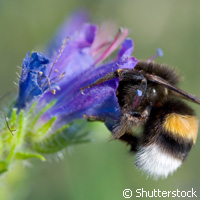The new buzz on bees and pollen
Collecting pollen is one of the most important tasks a bee has. But as they buzz around the flowering plants, what protects plants from losing too much pollen? New research from Switzerland shows how flowering plants complement their structural defence mechanisms by using chemical weaponry to ensure that bees do not collect too much pollen. The findings are published in the British Ecological Society's journal Functional Ecology. Claudio Sedivy from the Institute of Plant, Animal and Agroecosystem Sciences at Eidgenössische Technische Hochschule (ETH) Zürich and his team investigated this phenomenon by using a clever method to collect pollen from four plant species - bees! Bees, and not the researchers, harvested pollen from the nests of specialist bees that collect pollen from four specific plant species: buttercup, tansy, wild mustard and viper's bugloss. The team then fed the pollen to larvae of two very closely related solitary bee species, Osmia bicornis and Osmia cornuta. In nature, these larvae would enjoy a varied diet consisting of pollen from 18 and 13 species of plant respectively. For this study however, the larvae were split into groups, each of which was fed just one kind of pollen. The researchers discovered major differences in the ability of these generalist mason bees to grow on pollen from the same plant species. 'While the larvae of Osmia cornuta were able to develop on viper's bugloss pollen, more than 90% died within days on buttercup pollen,' explains Mr Sedivy, a doctoral student and lead author of the study. 'Amazingly, the situation was exactly the opposite with the larvae of Osmia bicornis. And both bee species performed well on wild mustard pollen, while neither managed to develop on tansy pollen. As far as we know, this is the first clear experimental evidence that bees need physiological adaptations to cope with the unfavourable chemical properties of certain pollen.' Osmia bicornis developed on buttercup pollen but did not on viper's bugloss pollen. The opposite was true for Osmia cornuta, with the exception of two larvae grown on buttercup pollen that developed into dwarfish adults. 'Both bee species performed well on Sinapis [wild mustard] pollen, while neither of the two species managed to develop on Tanacetum [tansy] pollen,' the authors say. The researchers say the flowering plants are right in their stance to protect themselves. Bees require huge amounts of pollen to feed their young. This pollen could be used by the plants for pollination. According to them, the pollen of up to several hundred flowers is used to rear just one larva. Bees are such resourceful pollen gatherers that they successfully collect around 80% of pollen contained in a flower during a single visit. The main problem is that because the bees store the gathered pollen in their gut or in special hairbrushes, flowers are not pollinated. Ecologists say bees deplete over 95% of the total pollen amount produced by their hosts. Between 20,000 and 30,000 bee species exist on our planet. 'Bees and plants have conflicting interests when it comes to pollen. While most plants offer nectar to visiting insects as a bait for insects to transport the pollen from flower to flower, bees are very efficient pollen collectors,' Mr Sedivy says. 'Therefore, plants have evolved a great variety of morphological adaptations to impede bees from depleting all their pollen. This study provides strong evidence that pollen chemistry might be at least as important as flower morphology to constrain pollen loss to bees.'For more information, please visit: ETH Zürich:http://www.ethz.ch/index_ENFunctional Ecology:http://www.functionalecology.org/view/0/index.html
Countries
Switzerland



